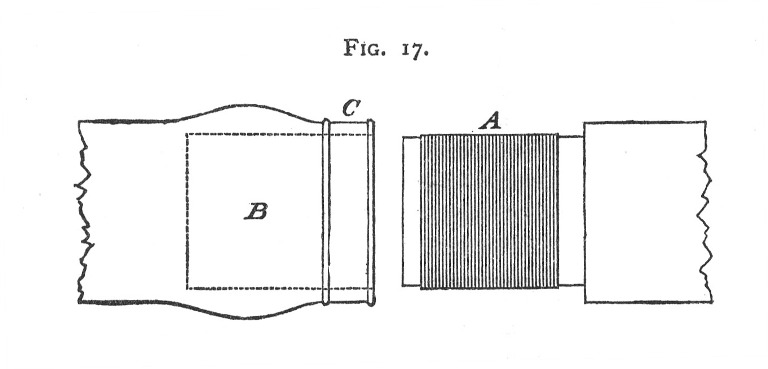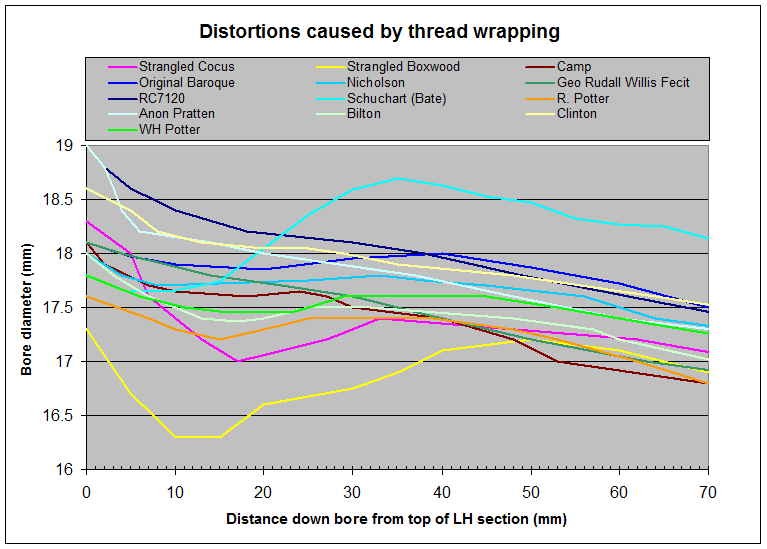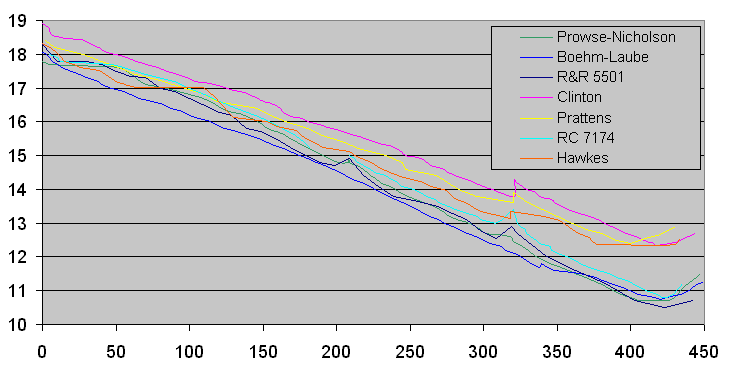|
Effects of Thread Wrapping series: A SurveyIntroductionOver recent years the writer has received for repair two 19th century flutes, one in boxwood, the second in cocuswood, where too-tight thread wrapping had dramatically damaged the tenons, causing significant reduction in bore diameter. Indeed, so significant, that when the thread was removed from the tenon, the tenon was distinctly "hour-glass" shaped, not cylindrical. The word "strangled" came immediately to mind. I'm defining strangulation as sufficient bore compression to cause a bottleneck in a bore that should have had a straightforward reducing taper. Most other 19th century flutes also show signs of less extreme bore compression. Reporting all this on the Chiff & Fipple flute forum led to a very lively debate as to whether or not thread tension could be enough to cause such damage, although no-one seemed able to suggest any other probable cause for the distortion. Clearly, there was a need to investigate. Lapping options - Cork vs ThreadDiscussion rages between proponents of thread wrapping and cork lapping on tenons in flutes. Thread wrapping has been around since flutes (and other woodwinds) started to be made in multiple parts in the baroque period. Cork lapping came much later - it seems to have made it to England in the early 19th century, but only deployed on distinctly up-market flutes. Thread wrapping enthusiasts quote the simplicity of the method, its stability with changing weather or flute usage patterns, the ease with which non-technical people can make any adjustments as what attracts them. They dislike cork because of a perceived risk to the socket if the cork is put on too thick, although surely this applies to thread equally if not more. Cork enthusiasts (like the writer) feel they have overcome any corking problems, enjoy the method and the results they get, and are concerned that the tightness of thread can pose problems to the flute bore, especially over time. Rockstro on the topicNow, it would be useful to get an historical view on lapping materials. And if you want an opinion on something, why not turn to someone known to be opinionated? Rockstro, of course! He tells us...
Ouch! Low priced flutes, eh? But Rockstro's right. As the new cylinder bored flutes gained supremacy, our much loved conical 8-key flutes became the student flute of the day. They cost about one fifth of a Boehm flute by the same maker. The Boehm (or similar) flute got the cork, the 8-key flute got the thread. But Rockstro might have missed the boat on why the thread needed frequent renewal. He probably assumed wear, but, as we'll see as our story unfolds, it requires frequent renewal (or at least augmentation) because the wooden tenon below is shrinking away from below it. That's useful to be aware of, as it implies the problem was making itself felt even by Rockstro's time (he was playing and teaching 8-key flutes around the middle of the 19th century). A short surveyI went looking among flutes and flute data I had easy access to for evidence of bore compression and strangulation. I hoped to find flutes showing varying levels of damage, and, guess what? Richness beyond the dreams of avarice! The results are shown in this graph:
I've sorted them into provisional categories, and advanced definitions for each... Seriously strangled flutesThese are flutes where bore compression is so advanced that a significant bottleneck forms under the tenon area, constricting operation of the flute. The bore minimum under the tenon is more than 1mm less than the rest of the bore might suggest at that point. The acoustic and aerodynamic impact on the performance of the flute is dramatic.
Moderately strangled flutesBore compression under the tenon forms a milder bottleneck (less than 1mm) followed by a region with reversed taper.
Flutes "on or about the cusp of strangulation"Bore compression has been enough to flatten out the taper, but not yet cause a bottleneck. Nonetheless, the mixture of acoustic and aerodynamic disruption is likely to weaken flute response.
Flutes showing bore compression, but not strangledSuch flutes will show compression to the bore, but not to the extent that the original taper is negated or reversed. At this level, impact on performance should be slight.
Flutes with no sign of compressionSuch flutes will show a straight or otherwise plausibly intentional taper. They serve to remind us what general form the other flutes should take.
Time to count headsI could go on, adding flutes to the survey above, until I run out of flutes. But the graph is already rather cluttered, so I think time to pause and do a tally. Ignoring the cork-lapped flute, then, we have looked at 12 thread-lapped flutes. Of these, and rounding the numbers:
Ideally of course, we would have a much bigger sample size - that could be achieved by a trip around the museums such as I had done in 2002. But even if a large sample halved the figures above, they would still tell a dismal story, and one we can hardly ignore.
If we look again at the survey graph (replicated here for your convenience), we can see a wide variety in the shape of the damage. The main compression always takes place within the thread-wrapped area (generally from about X= 5mm to X= 25mm), clearly implicating the thread. But the degree of compression at the opening (X=0) varies a lot, as does the distance down the tube that the damage continues. Some are U-shaped, which is what I'd expect, but some are V-shaped. I imagine there are a lot of factors involved here, such as wood type, wall thickness, thread band depth, existence or not of shoulders forming a thread trough, and so on, depth and perhaps even regularity of thread combing. This is going to make it hard for makers and restorers to work out what the dimensions should have been!
We're tempted to imagine that the tenon is made of a homogeneous stuff, like plastic, that will behave in a linear, predictable sort of way. But in fact it's made of fibres, running lengthwise, made up of empty cells. And the outer ones have been slashed across every mm or so by the thread retention grooves, not necessarily to the same depth. And with a tapered bore inside, leaving the tip end wall the thinnest. And open at one end, but more well supported at the other by the thicker body wall. So, complex and asymmetrical. Put a death grip on that, and why should it behave in a simple way? But, short of slicing along the tenon and examining it on the scanning electron microscope, how can we find out what it is doing? CAT scan, maybe? Explains a few bumpsInteresting now to look at the RC7174 (Rudall Carte, aqua) and R&R 5501 (Rudall & Rose, black) curves in the chart below. Note the flares at the ends of the LH sections (at around X=210mm) and the RH sections (at around X=320mm). Are they, as sometimes claimed, deliberate flares introduced by the maker, or are they the result of severe bore compression? The location and amounts are consistent with bore compression. Most of the flutes also seem to have signs of compression at the top ends (around X=15mm).
Conclusions so farI must say I was surprised to find so much evidence of thread wrap-induced distortion, and to find some of it so pronounced. Working with old flutes, one is accustomed to finding bores that seem a bit odd, but it's only when we get a bunch of them together in one place does the pattern emerge so forcibly. It's probably worth pointing out that, while the topic of bore compression has been mentioned from time-to-time, nobody to my knowledge has previously delved into it and presented their findings.
|


